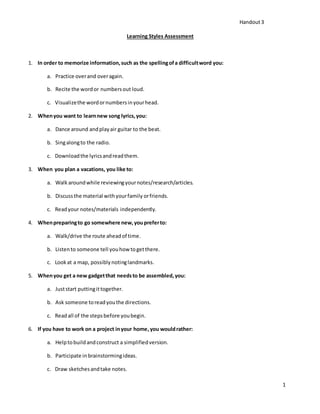
Handout 3 Defining Roles and the Necessary Skills for the 21st Century Paraeducator
- 1. Handout3 1 Learning Styles Assessment 1. In order to memorize information,such as the spellingofa difficultword you: a. Practice overand overagain. b. Recite the wordor numbersout loud. c. Visualizethe wordornumbersinyourhead. 2. Whenyou want to learnnew song lyrics,you: a. Dance around andplayair guitar to the beat. b. Singalongto the radio. c. Downloadthe lyricsandreadthem. 3. When you plan a vacations, you like to: a. Walkaroundwhile reviewingyournotes/research/articles. b. Discussthe material withyourfamily orfriends. c. Readyour notes/materials independently. 4. Whenpreparingto go somewhere new,youpreferto: a. Walk/drive the route aheadof time. b. Listento someone tell youhowtogetthere. c. Lookat a map, possiblynotinglandmarks. 5. Whenyou get a new gadgetthat needsto be assembled,you: a. Juststart puttingittogether. b. Ask someone toreadyouthe directions. c. Readall of the stepsbefore youbegin. 6. If you have to work on a project inyour home,you wouldrather: a. Helptobuildandconstruct a simplifiedversion. b. Participate in brainstormingideas. c. Draw sketchesandtake notes.
- 2. Handout3 2 7. If you decide to take a class, you tend to like classesthat include: a. Hands-onexperiments. b. Lots of lectures. c. Readingassignments. 8. Whenyou are distracted,you most oftenfindyourself: a. Fidgetingorplayingwithyourpencil. b. Listeningtoor participatinginconversations. c. Doodling. 9. Whenyou work at solvinga challengingproblem,do you: a. Make a model of the problemorwalkthroughall of the stepsinyourmind? b. Call a fewfriendsortalktoan expertforadvice? c. Create a listof the stepsyou needtotake and checkthemoff as they’re done? Once you have finished,addupthe numberof a’s,b’s,and c’s. Tallyyouranswersand“Voilà!”youhave a snapshotof howyou learnbest!If youansweredmostly “a”,youare primarilyakinestheticlearner.If youansweredmostly 2’s:“b”, youare an auditorylearner,andif youansweredmostly 3’s:“c”, youare largelyavisual learner.Now thatyouknowthe wayyou learnbest,it’stime toput thatinformationtogooduse! Amountof “a” : ______________ Kinestheticlearner Amountof “b” : ______________ Auditorylearner Amountof “c” : ______________ Visual learner
- 3. Handout3 3 Practical Strategies To Implement In The Classroom Visual Learners Learn through seeing and retain more information when it’s presented in the form of pictures, diagrams, visual presentations, textbooks, handouts and videos. • Enlarge text • Read text aloud • Highlight text/mark words that are unclear • Begin lesson with image(s) to see the big picture, frame of reference • Give summary of informative article before student reads whole piece • Use maps and charts to help clarify information • Use graphic representations to get ideas down and organized before writing assignment • Combine images with text to increase comprehension • Use “real images” or video to integrate current and past knowledge • Offer visual representation of relationships between concepts and reinforce content with videos and power points • Offer, “Mind Mapping” where ideas are charted out in a visual format for organizing thoughts, keeping track of ideas, notes, flow charts Auditory Learners Do best in classes where listening is a main concern. These learners prefer verbal lectures and discussions. • Highlighting individual words and hearing them read or hearing an entire selection or article • Hearing students’ own words read by the computer • Consider pre-reading to increase comprehension • Text to Speech tools can be accessible for variety of materials (speaking presentations, speech/audio converters, digital stories, notes/class information into audio format) • Audio tools can be accessed and explored (audio books, talking text software) to support comprehension • Reinforce content with videos, podcasts, e-books • Audio formats enable students to listen to text on CD or MP3 player Kinesthetic Learners Do best whenthey interact and touch things. These learners prefer a hands-on approach to learning and enjoy interacting with classroom materials and those around them. • Use interactive white board whenever possible for engaging activities • Enhance instruction through music, role play, hands-on activities, cooperative learning • Build movement into learning • Evaluate students through project-based or inquiry-based learning • Provide opportunities for individual, pair, group work, and peer learning • Present background information for new concepts using artifacts, videos, and other materials that are not lecture-based • Offer reinforcement through virtual field trips, field trips, e-field trips, guest speakers
- 4. Handout3 4 Practical Strategies for the Individual Strategies for the Kinesthetic Learner (learns best by doing — “hands on”) Pace or walk around while referencing your notes and reciting to yourself. If you need to fidget, try doing so in a way which will not disturb others. Use the Tangle Jr., Wikki Sticks, or a stress ball. You might not study best while at a desk. Try lying on your stomach or back on a comfortable lounge chair. Studying with music in the background might suit you (instrumental music is best – as opposed to heavily rhythm-based music). While studying, take frequent breaks. A reasonable schedule would be 20-30 minutes of study, and 5 minutes of break time. Strategies for the Auditory Learner(learns best by hearing) Study with a friend, parent, or group so you can discuss and hear the information. Recite out loud the information you want to remember several times. Make your own tapes of important points you want to remember and listen to it repeatedly. This is especially useful for learning material for tests. When doing math calculations, use grid paper to help you set your sums out correctly and in their correct columns. Use different colors and pictures in your notes, exercise books, etc. This will help you remember them. Strategies for the Visual Learner (learns best by seeing) Try to work in a quiet place. Some visual learners like soft music in the background. When studying, take many notes and write down lots of details. When trying to learn material by writing out notes, cover your notes then re-write. Rewriting will help you remember better. Use color to highlight main ideas. Before reading a chapter or a book, preview it first by scanning the pictures, headings, terms in bold and so on. When creating flashcards, always add a picture cue to aide memory.
